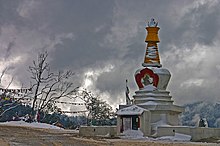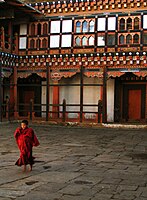Trongsa Dzong
| Trongsa Dzong Chhoekhor Raptentse Dzong Choetse Dzong | |
|---|---|
Shabdrung Ngawang Namgyal in 1647. |
Trongsa Dzong is the largest
Trongsa Dzong, the largest dzong at a striking location, is an important administrative building, providing the headquarters of the government of
Geography
The Dzong and the small town surrounding it are situated on a spur, a wild rocky area, above the ravines of the

Approach to Trongsa, till 1970, was only from the upper reaches of the Mangde Chu valley, starting the descent to the Trongsa town and the dzong from the location of two small chortens at Chendebji (One built by Lama Shida in
From Thimpu, the capital city on the west, the journey is by road, of about 7 hours, passing through mountain ranges on the east and west directions. The road is aligned above the Dzong, passes through a vegetable market and then through a small palace. This palace is where the late king
History

Trongsa means "the new village" in Bhutanese, which comprises retreats, temples and hermitages of monks.

In 1647, the great-grandson of Ngagi Wangchuk, Shabdrung Ngawang Namgyal, noted for the building of several other prominent buildings in Bhutan, began constructing a dzong in Trongsa, given its strategical importance.
Sir Ugyen Wangchuck, the first ruler of Bhutan was the Penlop at Trongsa before he was crowned the King of Bhutan in 1907. However, he retained the position of Penlop as well.[1][8]
In 1652,
Trongsa Dzong was heavily damaged following the 1897 Assam earthquake. It underwent major repair and was restored by both the 1st king, Ugyen Wangchuck and the 2nd king, Jigme Wangchuck in 1927, who renovated the Chenrezig Lhakhang in particular.[3] In 1999, funding from Austria led to extensive restoration works and was reconsecrated in October 2004, coinciding with the enthronement of the Crown Prince.[3]
The old village of Trongsar is located below, but there is a new village of Trongsar, which has been under construction on the mountainside since 1982. Tibetan immigrants settled in the valley in late 1950s and early 1960. The shopkeepers are mainly of Bhutanese and Tibetan origin.[1][2]
Architecture


Trongsa Dzong is a powerfully built fortress and is exemplary of
Ta Dzong, the watch tower, that was in the past a stronghold against internal insurgencies, towering over the east side of the dzong, has since been converted into a state-of-the Art Museum (National Museum) with technical and financial support provided by Austria. The tower also houses a chapel dedicated to the Jigme Namgyal who was penlop in the 19th century. It is also stated that in the dungeon of the tower two British soldiers were imprisoned during the Duar War.[6][10] The Ta Dzong tower originally was a highly fortified six-storied tower, with numerous galleries in the thick walls for defense. Further fortifications in the form of three independent towers were added at a higher elevation in close vicinity of the Ta Dzong.[11]
Aside from its central administrative offices, Trongsa is a major monastery and today houses around 200 monks.
Festival
A five-day festival known as the Trongsa
Gallery
-
One side of the Dzong
-
A panoramic view of the Trongsa Dzong within Trongsa town setting
-
Inner courtyard of Trongsa Dzong
-
Front entrance to the Dzong
-
View of Trongsa Dzong (2001)
References
- ^ a b c d e f Dorje (1999), p. 856.
- ^ ISBN 978-1-74059-529-2.
- ^ a b c d e f g h i Pommaret (2006), p.211.
- ^ a b c d e f g h i j k Pommaret (2006), p.212
- ^ ISBN 1-84353-048-1.
- ^ ISBN 978-81-8324-265-3.
- ^ ISBN 978-1-59311-735-1.
- ^ Journal of the Royal Central Asian Society, Volume 17. Royal Central Asian Society. 1930. p. 215.
- ^ a b c Pommaret, p. 213
- ^ a b c Brown, p.164
- ISBN 1-84383-066-3.
Bibliography
- Dorje, Gyurme (1999) (1999). Footprint Tibet Handbook with Bhutan. Footprint Books, Bath, England. p. 856. ISBN 1-900949-33-4.)
{{cite book}}: CS1 maint: numeric names: authors list (link - Pommaret, Francoise (2006). Bhutan Himalayan Mountains Kingdom (5th ed.). Odyssey Books and Guides. ISBN 962-217-757-3





